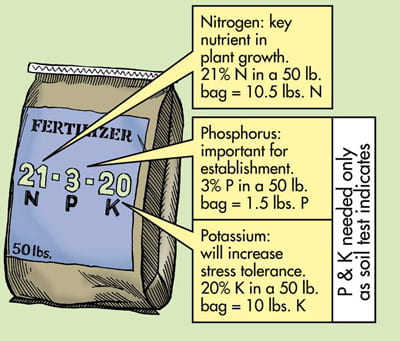
Complete fertilizers will have the 3 most important macronutrients nitrogen, phosphorus and potassium (N-P-K) and will be stated on the fertilizer bag. The numbers on the bag are always written in the same order and indicate the fertilizer analysis which is the percent (%) of nitrogen, phosphorus (as an oxide P2O5) and potassium (as soluble potash K2O) by weight. In a 100 lb bag of 20-5-10, 20% would be the nitrogen (or 20 lbs), 5% would be the phosphorus source (or 5 lbs) and 10% would be the potassium source (or 10 lbs). The remaining material is needed to help spread the fertilizer or may just be part of the N, P or K and not added to make if spread better.
Another fertilizer term worth knowing is fertilizer ratio. That is the proportion of the nutrients to each other. A fertilizer with the analysis of 20-20-20 has a 1:1:1 ratio as does 30-30-30. A fertilizer with a 20-5-10 analysis has a 4:1:2 ratio.
A starter fertilizer is one that has a higher percent of phosphorus which is beneficial at the time of seed establishment and overseeding if soils are low in P. Examples include: 18-24-12 and 16-25-12.
Commonly used abbreviations and symbols
| Unit | Abbreviation or symbol | Examples |
|---|---|---|
| Ounces | oz. | Apply 5 oz. each time |
| Pound | lb. or # | Apply 3 lbs. or Apply 3# |
| Cubic Yards | cu. yd. or yd3 | Apply 75#/ cu. yd. or Apply 75#/yd3 |
| Square feet | sq. ft. of ft2 | Apply 5#/ 1,000 sq. ft. or Apply 5# 1,000 ft2 |
| Acre = 43,560 sq. ft. | A | Apply 500#/A |


